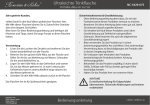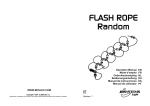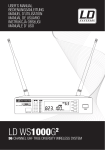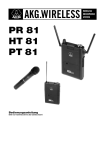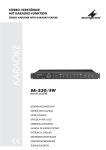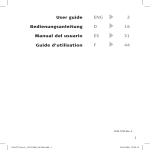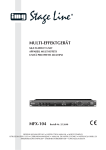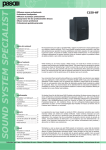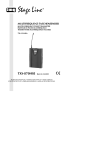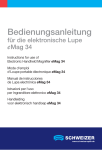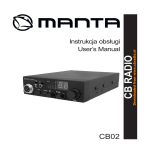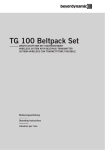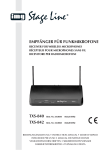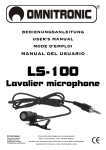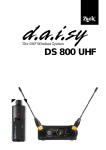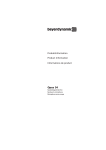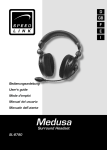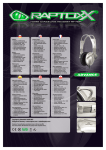Download Manuales de instrucciones
Transcript
HSE-152/SK HSE-152/SW Best.-Nr. 23.4280 D A CH Best.-Nr. 23.4290 Kopfbügel-Mikrofon Bitte lesen Sie diese Bedienungsanleitung vor dem Betrieb gründlich durch und heben Sie sie für ein späteres Nachlesen auf. 1 Einsatzmöglichkeiten Das unauffällige und ultraleichte Kopfbügel-Mikrofon HSE-152 /… eignet sich optimal für Gesangsund Sprachanwendungen, die viel Bewegungsfreiheit erfordern. Für den Betrieb wird zusätzlich ein Speiseadapter (z. B. EMA-1, EMA-2, EMA-40, EMA-300P) oder zur drahtlosen Tonübertragung ein Taschensender (TXS-...HSE) von „img Stage Line“ benötigt. ● Verwenden Sie für die Reinigung nur ein trockenes, weiches Tuch, niemals Chemikalien oder Wasser. ● Wird das Mikrofon zweckentfremdet, falsch ange- schlossen oder nicht fachgerecht repariert, kann keine Haftung für daraus resultierende Sachoder Personenschäden und keine Garantie für das Mikrofon übernommen werden. Soll das Mikrofon endgültig aus dem Betrieb genommen werden, übergeben Sie es zur umweltgerechten Entsorgung einem örtlichen Recyclingbetrieb. 3 Inbetriebnahme 2 Hinweise für den sicheren Gebrauch Das Mikrofon entspricht allen erforderlichen Richtlinien der EU und ist deshalb mit gekennzeichnet. ● Setzen Sie das Mikrofon nur im Innenbereich ein und schützen Sie es vor Tropf- und Spritzwasser, hoher Luftfeuchtigkeit und Hitze (zulässiger Einsatztemperaturbereich 0 – 40 °C). GB Headband Microphone Please read these operating instructions carefully prior to operating the unit and keep them for later use. 1 Applications The inconspicuous and ultralight headband microphone HSE-152/... is ideally suited for vocal sound and speech applications which require much freedom of movement. For the operation, additionally a power supply adapter (e. g. EMA-1, EMA-2, EMA-40, EMA-300P) or for wireless audio transmission a pocket transmitter (TXS-...HSE) from “img Stage Line” is required. 2 Safety Notes The microphone corresponds to all required directives of the EU and is therefore marked with . ● The microphone is suitable for indoor use only. Protect it against dripping water and splash water, high air humidity, and heat (admissible ambient temperature range 0 – 40 °C). ● For cleaning only use a dry, soft cloth, by no means chemicals or water. F B CH Microphone serre-tête Veuillez lire la présente notice avec attention avant le fonctionnement et conservez-la pour pouvoir vous y reporter ultérieurement. w w w.imgstageline.com 1 Possibilités d’utilisation Le microphone serre-tête HSE-152/..., discret et ultra léger, est idéalement adapté pour des applications de discours et de chant requérant une grande liberté de mouvements. Pour le fonctionnement, un adaptateur d’alimentation (p. ex. EMA-1, EMA-2, EMA-40 ou EMA-300P) ou un émetteur de poche (TXS-…HSE) de “img Stage Line” pour la transmission audio sans fil est en plus nécessaire. 2 Conseils d’utilisation et de sécurité Le microphone répond à toutes les directives nécessaires de l’Union Européenne et porte donc le symbole . ● Le microphone n’est conçu que pour une utilisa- tion en intérieur. Protégez-le de tout type de projections d’eau, des éclaboussures, d’une humidité élevée et de la chaleur (plage de température de fonctionnement autorisée : 0 – 40 °C). ® 1) Das Kopfbügelmikrofon aufsetzen und die Mikrofonkapsel dicht vor dem Mund in eine günstige Sprechposition bringen. Dazu lässt sich der Mikrofonarm schwenken und in der Gelenkhalterung verschieben und drehen. eines Speiseadapters diesen an den Mikrofoneingang eines Audiogerätes anschließen. 4 Technische Daten Mikrofontyp: . . . . . . . . . . Richtcharakteristik: . . . . . Frequenzbereich: . . . . . . Impedanz: . . . . . . . . . . . . Empfindlichkeit: . . . . . . . Maximaler Schalldruck: . Stromversorgung: . . . . . . Back-Elektret Niere 20 – 20 000 Hz 1,5 kΩ 1,8 mV/Pa bei 1 kHz 130 dB 1,5 – 9 V über Speiseadapter oder Taschensender Gewicht: . . . . . . . . . . . . . 7 g Anschluss: . . . . . . . . . . . 1-m-Kabel mit 3-pol. Mini-XLR-Kupplung 3 1 2 1 = Masse 2 = Audiosignal 3 = Stromversorgung 2) Die Mini-XLR-Kupplung des Mikrofonkabels in die Eingangsbuchse des Taschensenders oder des Speiseadapters stecken. Bei Verwendung Änderungen vorbehalten. ● No guarantee claims for the microphone or liabil- 4 Specifications ity for any resulting personal damage or material damage will be accepted if the microphone is used for other purposes than originally intended, if it is not correctly connected, or not repaired in an expert way. If the microphone is to be put out of operation definitively, take it to a local recycling plant for a disposal which is not harmful to the environment. 3 Setting into Operation 1) Put on the headband microphone and place the microphone cartridge close to the mouth into a favourable talk position. For this purpose the microphone arm can be moved, and be displaced and turned in the joint support. 2) Connect the mini XLR inline jack of the microphone cable to the input jack of the pocket transmitter or power supply adapter. When using a power supply adapter, connect it to the microphone input of an audio unit. ● Pour le nettoyer, utilisez uniquement un chiffon sec et doux, en aucun cas de produits chimiques ou d’eau. ● Nous déclinons toute responsabilité en cas de dommages matériels ou corporels résultants si le microphone est utilisé dans un but autre que celui pour lequel il a été conçu, s’il n’est pas correctement branché ou s’il n’est pas réparé par une personne habilitée ; en outre, la garantie deviendrait caduque. Lorsque le microphone est définitivement retiré du service, vous devez le déposer dans une usine de recyclage adaptée pour contribuer à son élimination non polluante. 3 Fonctionnement 1) Mettez le microphone serre-tête et positionnez la capsule micro près de la bouche dans une position favorable pour parler. Pour ce faire, le bras du microphone peut bouger, être déplacé et tourné sur le support de l’articulation. 2) Reliez la fiche mini XLR du cordon micro à la prise d’entrée de l’émetteur de poche ou de l’adaptateur d’alimentation. Si vous utilisez un Microphone type: . . . . . . Pick-up characteristic: . . Frequency range: . . . . . . Impedance: . . . . . . . . . . . Sensitivity: . . . . . . . . . . . SPL max.: . . . . . . . . . . . . Power supply: . . . . . . . . . back electret cardioid 20 – 20 000 Hz 1,5 kΩ 1,8 mV/Pa at 1 kHz 130 dB 1.5 – 9 V via power supply adapter or pocket transmitter Weight: . . . . . . . . . . . . . . 7 g Connection: . . . . . . . . . . 1 m cable with 3-pole mini XLR inline jack 3 1 2 1 = ground 2 = audio signal 3 = power supply Subject to technical modification. adaptateur d’alimentation, reliez-le à une entrée micro d’un appareil audio. 4 Caractéristiques techniques Type : . . . . . . . . . . . . . . . Caractéristique : . . . . . . . Bande passante : . . . . . . Impédance : . . . . . . . . . . Sensibilité : . . . . . . . . . . . Pression sonore max. : . . Alimentation : . . . . . . . . . back électret cardioïde 20 – 20 000 Hz 1,5 kΩ 1,8 mV/Pa/1 kHz 130 dB 1,5 – 9 V par adaptateur alimentation ou émetteur de poche Poids : . . . . . . . . . . . . . . 7 g Branchement : . . . . . . . . cordon 1 m de long avec mini XLR femelle 3 pôles 3 1 2 1 = masse 2 = signal audio 3 = alimentation Tout droit de modification réservé. Copyright © by MONACOR INTERNATIONAL GmbH & Co. KG, Bremen, Germany. All rights reserved. A-0479.99.01.01.2006 HSE-152/SK HSE-152/SW Best.-Nr. 23.4280 I Best.-Nr. 23.4290 Microfono headset Vi preghiamo di leggere attentamente le presenti istruzioni prima della messa in funzione e di conservarle per un uso futuro. 1 Possibilità d’impiego Il microfono headset HSE-152/…, non vistoso e ultraleggero, è indicato in modo ottimale per applicazioni di canto e di lingua parlata che richiedono molta libertà di movimento. Per il funzionamento è richiesto un adattatore di alimentazione (p. es. EMA-1, EMA-2, EMA-40, EMA-300P) oppure per la trasmissione audio senza fili, un trasmettitore tascabile (TXS-...HSE) di “img Stage Line”. Il microfono è conforme a tutte le direttive richieste dell’UE e pertanto porta la sigla . ● Far funzionare il microfono solo all’interno di locali e proteggerlo dall’acqua gocciolante e dagli spruzzi d’acqua, dall’alta umidità dell’aria e dal calore (temperatura d’impiego ammessa fra 0 – 40 °C). ● Per la pulizia usare solo un panno morbido, Micrófono de diadema Por favor, lea este manual de instrucciones detalladamente antes de hacer funcionar la unidad y guárdelo para una futura utilización. 1 Posibilidades de utilización El micro de diadema HSE-152/..., discreto y ultra ligero, está particularmente adaptado para aplicaciones de discurso y canto que requieren una gran libertad de movimientos. Para su funcionamiento, también es necesario un adaptador de alimentación (p. ej. EMA-1, EMA-2, EMA-40 o EMA-300P) o para la transmisión audio inalámbrica un emisor de petaca (TXS-…HSE) de “img Stage Line”. Se si desidera eliminare il microfono definitivamente, consegnarlo per lo smaltimento ad un’istituzione locale per il riciclaggio. 1) Sistemare il headset in testa e portare il microfono vicino alla bocca, in posizione adeguata allo scopo. Per fare ciò, il braccio del microfono può essere piegato nonché spostato e girato nel suo snodo. 2) Collegare la presa mini XLR del cavo microfono con la presa d’ingresso del trasmettitore tascabile oppure dell’adattatore di alimentazione. Se si usa ● Para limpiarlo, utilice solamente un trapo seco y suave, en ningún caso productos químicos o agua. daños materiales o corporales resultantes de una utilización del micro con otro fin que por el que ha sido fabricado, si no está conectado correctamente o si no ha sido reparado por una persona habilitada; además, carecería de todo tipo de garantía. Cuando el micro está definitivamente retirado del servicio, deposítelo en una fábrica de reciclaje adaptada para contribuir a su eliminación no contaminante. 3 Funcionamiento 1) Coloque el micrófono y posicione la cápsula micro cerca de la boca en una posición adecuada para hablar. Para hacerlo, el brazo del micro puede moverse y girarse sobre el soporte de la articulación. PL Mikrofon Osobisty Prosimy o uważne przeczytanie poniższej instrukcji przed użyciem urządzenia, oraz o zachowanie tekstu do wglądu. 1 Zastosowania Wyjątkowo lekki i dyskretny mikrofon nagłowny HSE-152/... jest przeznaczony do wokalu i mowy oraz zastosowań wymagających swobody ruchów. Aby korzystać z mikrofonu, niezbędny jest zasilacz (np. EMA-1, EMA-2, EMA-40, EMA-300P) lub w przypadku systemu bezprzewodowego nadajnik (TXS-...HSE) z oferty “img Stage Line”. 2 Informacje dotyczące bezpieczeństwa Ponieważ urządzenie spełnia wymogi obowiązujące w Unii Europejskiej, jest oznaczone symbolem . ● Mikrofon jest przeznaczony tylko do użytku wewnątrz pomieszczeń. Chroń przed wodą, wysoką wilgotnością i wysoką temperaturą (dopuszczalny zakres temperatury to 0 – 40 °C). ● Do czyszczenia obudowy używać suchej, ® 4 Dati tecnici Tipo: . . . . . . . . . . . . . . . . Caratteristica direzionale: Gamma di frequenze: . . . Impedenza: . . . . . . . . . . . Sensibilità: . . . . . . . . . . . Pressione sonora max.: . Alimentazione: . . . . . . . . back-elettrete cardioide 20 – 20 000 Hz 1,5 kΩ 1,8 mV/Pa con 1 kHz 130 dB 1,5 – 9 V tramite adattatore di alimentazione o trasmettitore tascabile Peso: . . . . . . . . . . . . . . . 7 g Collegamento: . . . . . . . . cavo 1 m con presa mini XLR a 3 poli 3 1 2 1 = Massa 2 = Segnale audio 3 = Alimentazione Con riserva di modifiche tecniche. dor de alimentación, conéctelo a una entrada micro de un aparato audio. ● Declinamos toda responsabilidad en caso de El micro cumple con todas las normativas que requiere la UE y es por esto que está marcada con . ción en interior. Protéjalo de todo tipo de proyecciones de agua, salpicaduras, una humedad elevada y del calor (temperatura de funcionamiento autorizada: 0 – 40 °C). w w w.imgstageline.com gliati o di riparazione non a regola d’arte del microfono, non si assume nessuna responsabilità per eventuali danni consequenziali a persone o a cose e non si assume nessuna garanzia per il microfono. 2 Consejos de seguridad y utilización ● El micro solo ha estado fabricado para la utiliza- un adattatore di alimentazione, collegarlo con l’ingresso microfono di un apparecchio audio. ● Nel caso d’uso improprio, di collegamenti sba- 3 Messa in funzione 2 Avvertenze di sicurezza E asciutto; non impiegare in nessun caso prodotti chimici o acqua. 2) Conecte la toma mini XLR del cable micro a la toma de entrada del emisor de petaca o del adaptador de alimentación. Si utiliza un adapta- miękkiej ściereczki. Nie stosować wody ani środków czyszczących. ● Producent ani dostawca nie ponosi odpowie- dzialności za wynikłe szkody materialne, jeśli urządzenie było używane niezgodnie z przeznaczeniem, zostało zainstalowane lub obsługiwane niepoprawnie lub poddawane nieautoryzowanym naprawom. Jeśli urządzenie nie będzie już nigdy więcej używane, wskazane jest przekazanie go do miejsca utylizacji odpadów, aby zostało utylizowane bez szkody dla środowiska. 3 Instalacja i podłączenie 1) Załóż mikrofon tak, aby znajdował się blisko ust i nie przeszkadzał w mówieniu. Dzięki przegubowi, mikrofon można ustawiać w odpowiedniej pozycji. 2) Podłącz mini jack XLR kabla mikrofonowego do wejścia nadajnika lub zasilacza. Gdy stosowany jest zasilacz, podłącz go do wejścia mikrofonowego urządzenia audio. 4 Características técnicas Sistema: . . . . . . . . . . . . . Características: . . . . . . . Banda pasante: . . . . . . . Impedancia: . . . . . . . . . . Sensibilidad: . . . . . . . . . . Presión sonora máxima: . Alimentación: . . . . . . . . . back electret cardioide 20 – 20 000 Hz 1,5 kΩ 1,8 mV/ Pa /1 kHz 130 dB 1,5 – 9 V por adaptador de alimentación o emisor de petaca Peso: . . . . . . . . . . . . . . . 7 g Conexión: . . . . . . . . . . . . cable 1 m de longitud con mini XLR hembra 3 polos 3 1 2 1 = masa 2 = señal audio 3 = alimentación Nos reservamos todo derecho de modificación. 4 Dane techniczne Typ mikrofonu: . . . . . . . . Charakterystyka: . . . . . . Pasmo przenoszenia: . . Impedancja: . . . . . . . . . . Czułość: . . . . . . . . . . . . . Maksymalny SPL: . . . . . . Zasilanie: . . . . . . . . . . . . elektretowy kardioidalna 20 – 20 000 Hz 1,5 kΩ 1,8 mV/Pa przy 1 kHz 130 dB 1,5 – 9 V przez zasilacz lub nadajnik osobisty Ciężar: . . . . . . . . . . . . . . 7 g Połączenie: . . . . . . . . . . . Kabel długości 1 m zakończony 3-pinowym wtykiem typu mini jack XLR 3 1 2 1 = masa 2 = sygnał audio 3 = zasilanie Może ulec zmianie. Copyright © by MONACOR INTERNATIONAL GmbH & Co. KG, Bremen, Germany. All rights reserved. A-0479.99.01.01.2006


